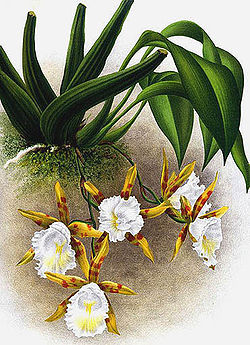| Trichopilia | |
|---|---|
 | |
| Trichopilia brevis | |
| Scientific classification | |
| Kingdom: | Plantae |
| Clade: | Tracheophytes |
| Clade: | Angiosperms |
| Clade: | Monocots |
| Order: | Asparagales |
| Family: | Orchidaceae |
| Subfamily: | Epidendroideae |
| Tribe: | Cymbidieae |
| Subtribe: | Oncidiinae |
| Genus: | Trichopilia Lindl. |
| Synonyms [1] | |
| |
Trichopilia, abbreviated Trpla. in the horticultural trade, is a genus of orchids. It consists of about 45 currently recognised species (as of June 2014), native to Mexico, Central America, the West Indies and South America. [1] [2]